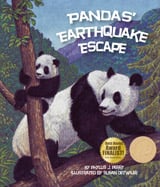Alignment to Standards for LA

| Grade | Number | Standard |
|---|---|---|
| 1 | G-1.1 | Identify and use simple map symbols and key/legend |
| 1 | G-1.2 | Interpret a simple chart |
| 1 | G-1.3 | Describe a map as a representation of a place |
| 1 | LS-1.26 | Describe the differences between plants and animals |
| 1 | LS-1.31 | Describe how animals and their offspring are similar and how they are different |
| 1 | LS-1.32 | Describe features of some animals that benefit them in their environments |
| 1 | SI-1.12 | how scientific discoveries have affected society |
| 2 | G-2.2 | Describe basic characteristics of maps and globes |
| 2 | LS-2.33 | Compare the life cycles of selected organisms (e.g., mealworm, caterpillar, tadpole) |
| 2 | LS-2.34 | Describe inherited characteristics of living things |
| 2 | SE-2.48 | Describe a variety of activities related to preserving the environment |
| 2 | SE-2.50 | Describe ways in which habitat loss or change can occur as a result of natural events or human impact |
| 2 | SE-2.51 | Describe and give examples of threatened or endangered species |
| 2 | SI-2.13 | Explain and give examples of how scientific discoveries have affected society |
| 3 | LS-3.35 | Compare structures (parts of the body) in a variety of animals (e.g., fish, mammals, reptiles, amphibians, birds, insects) |
| 3 | LS-3.38 | Classify groups of organisms based on common characteristics |
| 3 | SE-3.17 | how scientific discoveries have affected society |
| 3 | SE-3.58 | Describe how humans have had negative and positive effects on organisms and their environments |
| 4 | ESS-4.63 | Earthês surface is changed as a result of slow and rapid processes (e.g., sand dunes, canyons, volcanoes, earthquakes) |
| 4 | G-4.10 | Identify physical processes that change Earthês surface and create physical features suddenly or over time (e.g., what physical processes created the Grand Canyon, the Great Lakes, the Hawaiian Islands) |
| 4 | G-4.17 | Identify natural disasters, their causes, areas prone to them, and how those disasters affect people and the environment |
| 4 | LS-4.41 | Describe how parts of animalsê bodies are related to their functions and survival (e.g., wings/flying, webbed feet/swimming) |
| 4 | LS-4.47 | Sequence stages in the life cycles of various organisms, including seed plants |
| 4 | LS-4.49 | Compare similarities and differences between parents and offspring in plants and animals |
| 4 | LS-4.52 | Describe how some plants and animals have adapted to their habitats |
| 4 | LS-4.53 | Identify the habitat in which selected organisms would most likely live and explain how specific structures help organisms to survive |
| 4 | SI-4.22. | how scientific discoveries have affected society |
| 5 | ESS-5.32. | Demonstrate the results of constructive and destructive forces using models or illustrations |
| 5 | ESS-5.39 | Identify areas in which technology has changed human lives (e.g., transportation, communication, geographic information systems, DNA fingerprinting) |
| 5 | LS-5.24. | Describe the roles of producers, consumers, and decomposers in a food chain |
| 5 | LS-5.29. | Describe adaptations of plants and animals that enable them to thrive in local and other natural environments |
| 5 | SI-5.40 | Evaluate the impact of research on scientific thought, society, and the environment |
| K | G-K.1 | Identify a map and a globe as a representation of Earth |
| K | G-K.5 | Identify the difference between land and water and locate both on a map or globe |
| K | LS-K.28 | Observe life cycles and describe changes (e.g., humans, dogs, insects) |
| PK | LS-PK.20 | Give examples of different kinds of plants and different kinds of animals |
| PK | LS-PK.22. | Learn about animals and plants through nonfiction literature (For Creative Minds) |